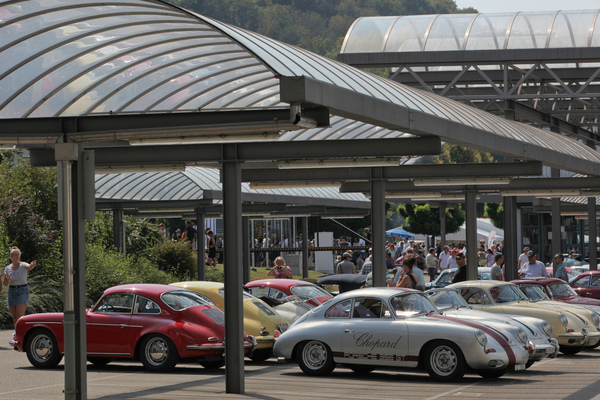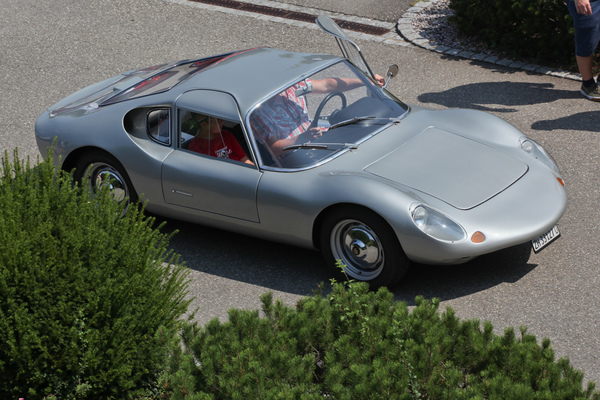If you were out and about in Schinznach-Bad on August 19, 2018, you probably wouldn't think it was a VW, but a Porsche. The Stuttgart sports cars were on the road at every traffic circle, on every stretch of road, almost everywhere.

It sounded like air-cooled six- and four-cylinder boxers, among which were of course also water-cooled engines, some even with 10 cylinders. Anyone who didn't already know it must have guessed it: It was Porsche Classic Day in Schinznach-Bad again.
Around 500 classic Porsches
And they really did come in droves, the Porsche drivers and fans. The older models up to 993/964 were allowed to park directly on the festival grounds, while the newer models were directed to parking lots in the surrounding area.

Virtually the entire range from the last 70 years was on display, including some rare examples.
Away from the 911 and co
Of course, the 911 models and their variants 964, 993, 996, 997 and 991 made up a significant proportion of the vehicles. But the Type 356 in particular was represented to an above-average extent, not only with the closed and open variants of the original Porsche, but also with a Zagato variant and a yet-to-be-identified coupé version, similar to an Apal GT.

And while we're at it, the Porsche 904 GTS also belonged to the plastic sports car category, arriving from Autobau Romanshorn and visibly causing a stir.
70 icons
The highlight of the day, however, was the arrival of the "70 icons". Organizer Hansueli Bächli, together with Marco Marinello, had managed to find an interesting model for every year of construction from 1948 to 2018. The vehicles drove onto the festival grounds from around 11:00 a.m., were then presented on a stage and finally parked in a specially designated parking lot in order of year of manufacture.

The first two rear-engined Porsches
The first two 356 models in particular were quite something, as they are hardly ever seen together in public. The Porsche 004 is a coupé that still stands out due to its peculiar roofline and, of course, the split windshield.
Porsche 003 was built as a convertible by the Beutler brothers in Thun. Both cars are in Swiss hands and are truly impressive icons.
If you were on the road between Brugg and Schinznach-Bad, you could even see the first two rear-engined Porsches in action.
From the 356 to the modern era
The 70 icons, actually there were 71, impressively represented the development of Porsche as a manufacturer.
Various 356s were driven up to 1964, including rare Speedster versions and a Carrera 2.
From 1965, the Porsche 911 dominated (together with its four-cylinder brother 912), interrupted only in 1970 by the 914/6.
In 1976, a Porsche 924 represented the beginning of the transaxle era, which was also represented by two 928s, a 944 and a 968.
The 964 and 993 era was represented by several models, as was the modern 996/997/991 era. And of course the Boxster and co. were not missing.
The exceptional Porsche
Porsche repeatedly built sports cars outside the "normal" 911 dynasty, such as the 959 in the 1980s, represented by a 959 S (ex-Karajan), the Carrera GT hyper sports car at the start of the new millennium and the 918 Hybrid in the modern era.
AMAG Schinznach-Bad was also able to find one of each of these three types. The sound of the Carrera GT alone made the hairs on the back of my neck stand up.
Celebration of colors
Now that most Porsches are anthracite/silver or black, it's hard to imagine the colorfulness of earlier Porsche decades.

But in Schinznach-Bad they were on display again, the most popular Porsche colors of the past such as Indian red, viper green or various shades of yellow and blue. The earlier vintages in particular impressed with a truly refreshing color palette.
Bratwurst and conviviality
Site manager Hansueli Bächli hardly had a moment's peace. He was constantly seeing old acquaintances and customers, shaking hands and waving to friends. As a host, he hardly ever got to bite into a sausage himself. But his guests were happy to help themselves and probably told each other stories from the good old days, when Porsche sports cars were still air-cooled and the highways and country roads were still free of speed limits.


















































































